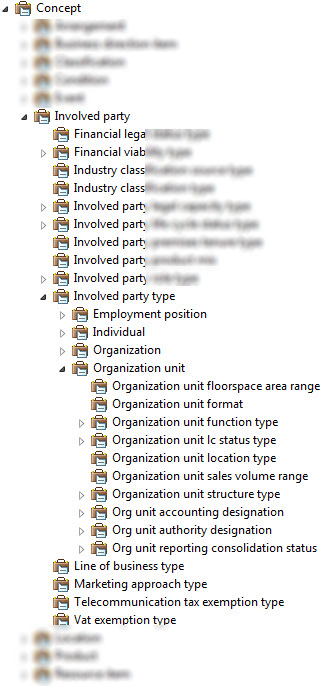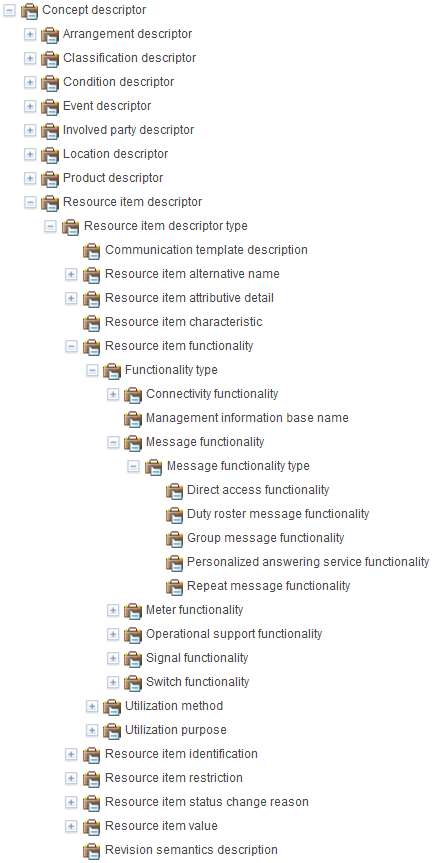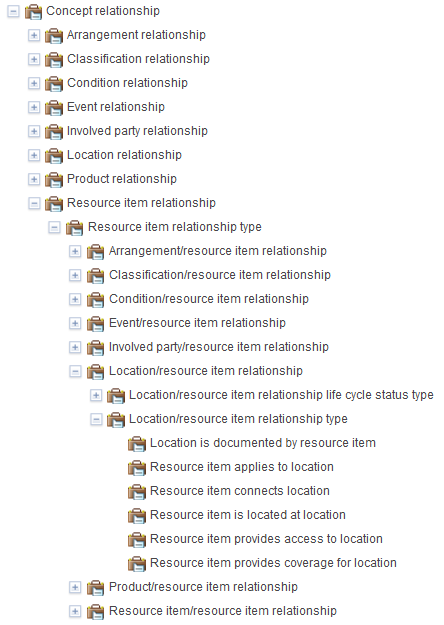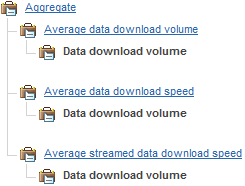Business terms hierarchies
The IBM Industry Models business terms are organized in hierarchies using the Is A Type Of/Has Types relationship. The hierarchies of primary and secondary terms support a taxonomy of business terms according to one or more viewpoints defined as classifier terms. The hierarchy of aggregate terms indicates the decomposition hierarchy of an aggregate term, based on the formula used to calculate it.
- Primary terms hierarchy
- Secondary terms hierarchy
- Relationship terms hierarchy
- Aggregate terms hierarchy
Primary terms classification hierarchy
Concept is the root term of the primary terms hierarchy, and is defined in the Business Terms category. The first level terms in the hierarchy are the root primary terms of each business category. These root primary terms are defined in each business category to serve as an anchor point for all primary terms of the business category, and to facilitate the navigation in the primary terms hierarchy.
- The structure of the layers in the hierarchy is rigid
- Each root primary term, such as Involved party, of a business category is the high-level supertype concept of which each other primary term in the hierarchy is a subtype. The second layer is a set of classifier terms, such as Involved party type and Involved party legal capacity type, that classify the root primary term according to one or more viewpoints. The third layer comprises primary terms, such as Individual and Organization, corresponding to the subtypes of the top primary term created by classifying it according to the classifier terms in the second layer. The fourth layer contains classifier terms, the fifth primary terms, and so on downward in alternating layers of classifier terms and primary terms.
- There is no redundancy of classifier terms or primary terms
- A classifier term or a primary term appears only once in the hierarchy. For example, Involved party legal capacity type classifier term classifies individuals and organizations. Involved party legal capacity type could have been placed under Individual and under Organization. However, this would break the redundancy rule. So, in order to place it only once in the hierarchy, it is placed higher in the hierarchy under Involved party.
- A classification does not necessarily apply to all instances of the concept represented by its parent primary term
- For example, Involved party legal capacity type is a meaningful classification for individuals and organizations, but it may not be a meaningful classification of organization units.
- The classified primary terms are mutually exclusive unless otherwise specified in the definition of the classifier term
- A specific instance of a concept that is classified can only be represented by one primary term from the set of primary terms resulting from the classification. For, example, at any one time, an individual can either be married or single but not both. Similarly, an organization can be registered or nonregistered but not both. However, in some cases, an instance of a primary term can belong to more than one subtype at one time. For example, an instance of an individual can be married and separated, and thus belong to two subtypes of Marital status classifier term at one time, Married and Separated.

Secondary terms classification hierarchy
Concept descriptor is the root term of the secondary terms hierarchy, including only the secondary terms that describe only one primary term. Concept descriptor is defined in the Business Terms category. The first level terms in the hierarchy are the root secondary terms of each business category. These root secondary terms are defined in each business category to serve as an anchor point for all secondary terms of the business category, and to facilitate the navigation in the secondary terms hierarchy.

Relationship terms classification hierarchy
Concept relationship is the root term of the relationship terms hierarchy, relationship terms that are secondary terms that describe two primary terms. Concept relationship is defined in the Business Terms category. The first-level terms in the hierarchy are the root relationship terms of each business category. These root relationship terms are defined in each business category to serve as an anchor point for all relationship terms of the business category and to facilitate the navigation in the relationship terms hierarchy.

Aggregate terms decomposition hierarchy
The aggregate terms decomposition hierarchy is based on the calculation formulas of aggregate terms. Each aggregate term or secondary term involved in a calculation formula is related to its parent aggregate term. When an aggregate term is not involved in any calculation formula, it is related to the Aggregate root term of the aggregate terms hierarchy. The Aggregate root term is defined in the Business Terms category. A numeric term can belong to multiple hierarchies when it is used to calculate multiple aggregate terms.
